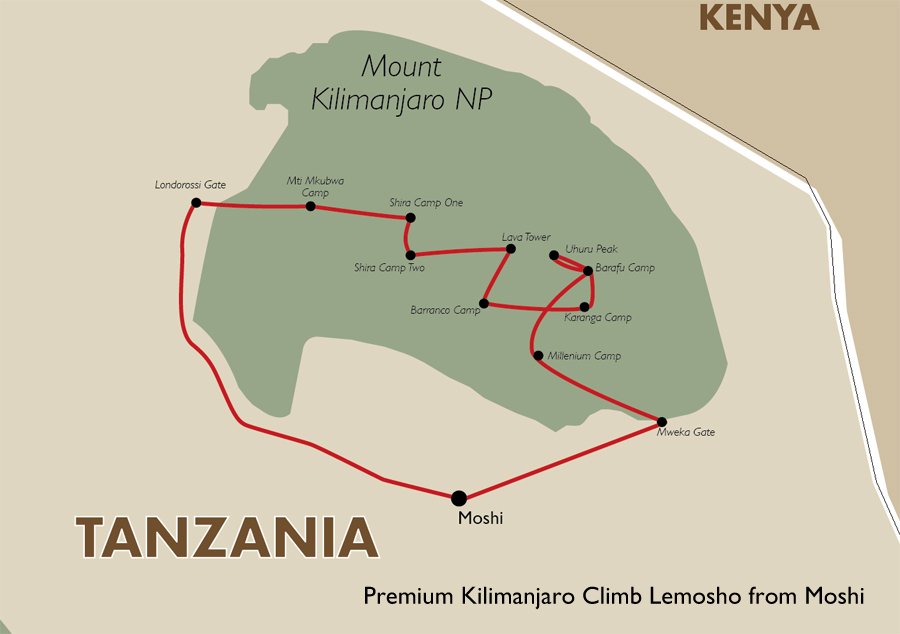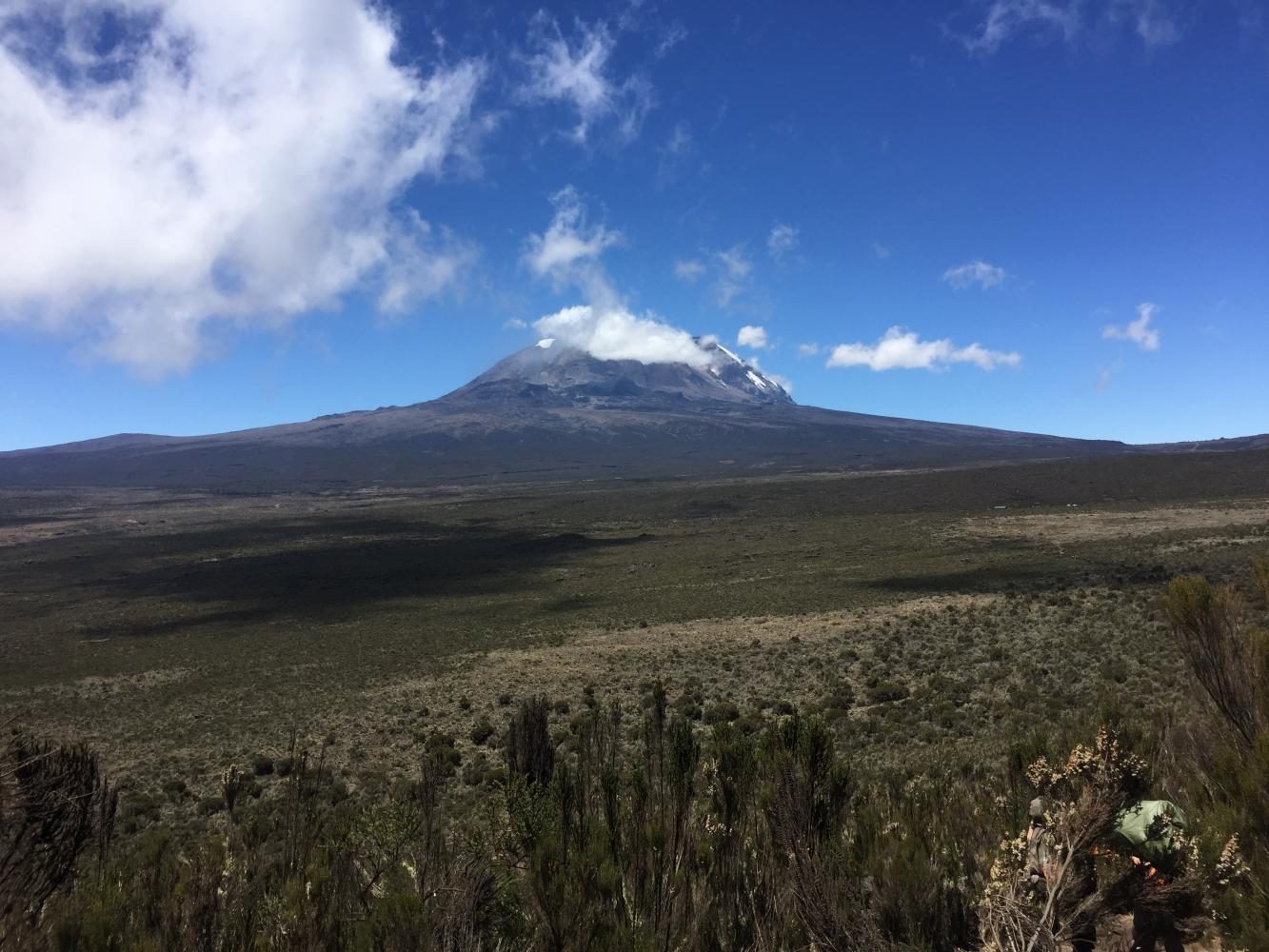Journey to the Roof of Africa
October 11, 2017
As I sat in a piano practice room on CMU’s campus, taking a breather between classes, a stray thought wiggled its way into the center of my thoughts. It was a summer day in August, and busy with my precollege program, I had no idea how the idea of climbing Mt. Kilimanjaro crept into my head, or even where I had picked it up. The previous and only time I acknowledged its existence was way back in early middle school, when I read a book about it. Surprised by this realization, I brushed off the thought and turned my attention back to Beethoven No. 8.
I was baffled when, after another sloppy play-through, the thought came back even stronger. But my phone alerted me that it was time to take my lunch break, and then head to my afternoon class.
That night, I googled some basic information about climbing the mountain and was surprised to learn it was not a technical hike, but simply a very long, uphill walk. Additionally, August would be that last month of the dry season, the perfect time to go if one wishes to not be waterlogged. This piqued my interest. I hadn’t traveled in a while, and the prospect of climbing the tallest mountain in Africa was becoming increasingly attractive. Additional research revealed a variety of routes, price ranges, and equipment, and with every click, I felt more and more inclined to take the trip.
The biggest obstacles remaining were booking and the question of my fitness. Most climbing operators recommended a long training regiment that spanned over three months, and most people booked well over a year in advance. And while I could still book a climb, two weeks is almost nothing for training. I decided that I would survive after I found out that children and the elderly have climbed the mountain, albeit with some extra assistance.
My departure date hastened forth. The initial wave of worry regarding everything that could go wrong unbalanced me, and I was scurrying back and forth all over the place. But 26 hours of flying and transfers gave me plenty of time to relax and reassure myself that everything would work out.
We touched down on the smallest airstrip I’ve ever seen. Kilimanjaro International Airport, in all its glory, was smaller than NAI. On the bright side, customs took under ten minutes, and after an hour-long drive, I was introduced to my fellow hikers at the hotel. I met Tapsi, an Indian engineer in her 30s, and Yoram, a 50 year old Israeli who was in senior management of a Wall Street firm. Minutes later, I was in a bed, trying to beat jet lag as soon as possible.
Day 1 was a breeze. The hardest part was the four-hour drive to the western end of the park, where the route I decided on, the Lemosho Trail, began. Moshi, the town that serves as the base for most climbers, was on the southern end. Most of the road was dirt path, subjecting of us to a loud and bouncy ride. To brighten things up, however, we unexpectedly encountered a tower of giraffes. After enduring a good bone rattling, we arrived at Londorossi Gate, the official start of the trail.
The ensuing three hours of walking was fairly easy. As we made our way through the jungle, we saw numerous monkeys and exotic birds. Aided by the cool, windy weather and a pair of hiking sticks, I didn’t even end up breaking a sweat. However, Tapsi didn’t fare as well, a grim indicator of the days to come. We arrived at the first campground (Mkubwa) fairly late, because we had to slow down for Tapsi. However, on the whole, day 1 was much easier than I thought it would be, and it bolstered my confidence.
The guides warned that day 2 would be far harder, and by all accounts, they were right. The Lemosho route starts not at the base of Kilimanjaro, but rather a two-and-a-half-day hike from it. Those days would be spent crossing numerous ridges, ultimately climbing up to Shira Plateau, on which the mountain sits. The vast majority of these ridge crossings fell on day 2, and the increasingly uneven and rocky path was a killer. However, I was able to go ahead of the rest of my group and walk at my own pace.
The words spoken most on the mountain are probably “Pole Pole,” Swahili for “slowly, slowly”. However, I was confident after day 1 and convinced my guides I would be fine. At one point, I looked up from the ground and was shocked that the giant trees had completely disappeared. I had unknowingly climbed out of the jungle and into the moorlands, dominated by medium-height shrubs and small trees. The scenery, no longer blocked by forest, was unimaginably awe-inspiring. The landscape was dominated by massive, rolling hills that were reminiscent of a Mongolian grassland, with no signs of humans in sight. An iPhone simply can’t do it justice, but I decided that pictures were to be a priority. Completely alone and ahead of the group, I had all the time in the world to stop and take them, admiring the views around every bend and at the top of every ridge.
The most defining moment came when I swung around the final ridge onto the plateau and saw Kilimanjaro for the first time with my own two eyes. At that moment, I decided that I would get onto the summit, no matter what happened. My resolve was sharpened, and there was no more stopping.
Feeling more motivated than I’ve ever been in my life, I took a short nap before eating dinner with the crew, got to know my fellow expeditioners better, and inevitably got into a heated discussion about American politics. Relieved and tired, but plagued by jetlag enhanced by the high altitude, I descended into a restless slumber.
Day 3 was boring. It was a typical seven-hour hike, taking us from the edge of the plateau (Shira Camp) to the base of the mountain (Moir Hut), and it was much less hilly than day 2. Tapsi started having some real issues with stamina and our guides wanted to stick together for the day because the trail was confusing in some places and getting lost would be catastrophic. It also started getting cold, but it ended up being a fairly easy day.
Day 4 was catastrophic. I woke up queasy and couldn’t stomach breakfast. Only ten minutes into our hike, with the camp only a few hundred meters behind, altitude sickness struck hard. Unfortunately, the symptoms hit me at my weaknesses.
I pride myself on having a fairly high pain tolerance, but there was no pain. Instead, I ran into wave after wave of debilitating nausea and dizziness. Thankfully, this happened on our acclimatization day, which meant there was no net elevation gain, and my body would have some time to adjust to the lower-oxygen environment. Halfway through the short day, I made a full recovery and was back to my cheerful self in time for dinner, much to the relief of my fellow climbers. However, the day planted a seed of nervousness in my mind. We climbed and then descended roughly 400 meters when I got sick, but the climb from base camp to summit would be 1,200 meters, triple what was enough to make me sick. I pushed the thought out of my mind and focused on getting as much sleep as I could.
Day 5 contained the most fun part of the climb for me — the Barranco Wall, an intimidating 250 meter cliffside that would take roughly an hour and a half to scale. The scrambling required by the slightly more technical nature of the wall was challenging but engaging, and a pleasant break from the endless grind of putting your one foot in front of the other.
However, my older colleagues didn’t fare as well — I climbed the wall nearly twice as fast, and Tapsi was seriously considering giving up on the climb altogether. She had been getting hit harder than I had been by the altitude and wasn’t in the best shape either. Yoram and I were forced to go ahead with one of our guides while the other guide stayed behind with her. At this point, the terrain had shifted once more, this time to alpine desert. There was essentially no more green — only red and jet black mosses and lichens, as well as some brown and dead-looking grasses. The “trail” was now a path of smaller and more fragmented rocks among boulders. A final grueling push after descending from the top of the wall and up another ridge saw us at Barafu Camp, better known as the base camp. From here, we would depart at midnight to make the final push onto the summit.
Over dinner, we jokingly dictated our last wills to each other, and quickly retreated to our tents to rest our sore limbs.
Night 5, going into day 6, was undoubtedly the hardest stretch of the climb, and one of the most exhausting days of my life. So far, although I’d been struck by altitude sickness once, I was doing much better than I had anticipated and had yet to be utterly drained.
However, Uhuru Peak didn’t disappoint. With dim headlamps as our only source of light, Yoram and I trudged forward with our guide. We had decided the night before that Tapsi would wait until sunrise before attempting a climb, in order to hopefully have an easier time. Ahead, we could see spots of lights where other climbers were making the same trek. The conditions were horrific. I had two pairs of gloves, but they were effectively useless in -30 degree windchill, forcing me to abandon the hiking poles and stuff my hands in my coat pockets. During our first break, I discovered that my phone battery, charged to full the night before, had been completely destroyed by the cold. There was also no longer a trail. Instead, we zigzagged up a steep slope, covered with half a foot of loose gravel and dust. Imagine Sister Agony between Carson and NAI, but steeper and under worse conditions. Such was life for seven-and-a-half long hours.
Finally, after a soul -rushing final push, we found ourselves on Stella Point, the sister summit of Uhuru. From here, it was only a flat 20-minute walk to the ultimate peak of Africa. Yorem said he needed to rest for a bit, so I staggered on alone. At this point, my lungs were making all kinds of weird croaking noises, and I felt like I was about to have a heart attack. But I was there, and then I was sitting on a rock, sobbing like a baby.
The rest of my time on the summit passed in a flash. Yoram arrived, and informed me that Tapsi had to turn back halfway up the summit because of altitude sickness. We took some photos, but mostly I just enjoyed the scenery, and tried my best to etch the moment into my memory. After roughly 20 minutes of celebrating, we began the descent.
I won’t get into much detail about the rest of my journey, but there are a few important things to note. First, my goal was the make it to the summit. I had joked before the summit that I would make it on top, but they may have to carry me down on a stretcher. This was almost the case, as the altitude took its toll on my head and with the sliding and bumping on the rocks during the descent, I felt like someone was repeatedly hitting me with in the face with a flashlight.
Second, I literally had negative energy in the tank, and we had another two-hour trek to a lower camp after returning to base. This trek took me four-and-a-half hours, walking at a snail’s pace. Even Tapsi beat me there by a good hour. I walked straight into my tent and fell asleep for a good twelve hours, the most I’d gotten on the mountain by a huge margin (we typically got around five hours a night).
Day 7 was an easy day. There are different routes up the mountain, but only one way down, called the Mweka route. This was exclusively a downward route, and the most direct path from bottom to summit. It’s also used for ferrying supplies and mounting rescues. In one instance, a runner ran up to the summit in a measly six-and-a-half hours, which really shows how short it is. Two hours of walking later, we arrived at the exit gate, and I unwinded with a couple sodas and Premier League soccer back at the hotel.
The next day, I was on a plane back home. It was Tuesday, school would start Thursday, and I still needed to read Crime and Punishment for English. That was fourth on the priority list, though. The top three? A shower, a haircut, and some cheeseburgers and ice cream. God, I missed dairy.













